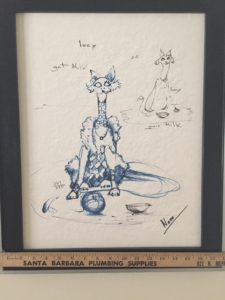 EF sent me a canvas giclee by the Colombian artist Nano Lopez. Nano used this sketch as a study for a bronze figure titled Lucy. The image size (without the frame) is 14.25 x 18” and the edition number (how many made in a series) is 280. EF has the 267 copy. Editions can range larger than stated on the canvas. Many artists make artist’s proofs and a few more for the print-house. So, a good question when you buy a print, EF, is the total size of an edition. The larger the edition size, the less rare the image, and often less valuable.
EF sent me a canvas giclee by the Colombian artist Nano Lopez. Nano used this sketch as a study for a bronze figure titled Lucy. The image size (without the frame) is 14.25 x 18” and the edition number (how many made in a series) is 280. EF has the 267 copy. Editions can range larger than stated on the canvas. Many artists make artist’s proofs and a few more for the print-house. So, a good question when you buy a print, EF, is the total size of an edition. The larger the edition size, the less rare the image, and often less valuable.
Nano (1955) grew up in Bogota Columbia with a grandmother who sculpted, and a metal sheet maker father. In 1980 he studied at the Ecole Nationale Superieure des Beaux Arts in Paris. He made a mark as a master enlarger, an expert in preparing the technology around models. He founded a series of animal sculptures called Nananimals.
A Study for Lucy Bronze Figure
Your giclee, a print process, but still multiple, inspired many Nano castings. Because his market likes these sketches, he capitalized and made copies of his sketches as he designed the bronze. I can’t post a photo of that bronze because of copyrighted, but here’s how your sketch ‘grew up.’
After sketching Lucy, Nano modeled her in clay in a small scale (called a maquette). Then he enlarged her to actual size in clay. He added little found objects to the clay sculptures. Then he coated her with silicone. Then he fitted a master mold, called the mother, over the pliable silicone.
Now we enter the meat of the process
Called “the lost wax process,” created for decades upon decades, the artist aspires to create a sculpture of bronze matching the model of clay, the original design.
Now the artist pulls the rubber mold surrounded by the mother from the clay. He then pours hot wax in the silicone supported by the mother. And the wax cools.
Craftsman make ‘gates’ which are armatures or supports and openings, for the poured molten bronze. Then they paint a coating, called a slurry, of liquid ceramic over the wax, which hardens to the shape and texture of the original piece. In an inconspicuous place the wax seal, called the cap, is broken. Now the mold goes into the kiln, and all the wax melted away, so all that remains is the mold itself.
At this point they pour 2,100-degree molten bronze in the mold, filing the once wax empty shell. The metal takes the form of the original model when it hardens, but first a craftsman with a pneumatic hammer chips away the ceramic mold.
Now you will see the bronze resembling your sketch of Lucy.
The bronze is sandblasted, and for a complex sculpture, modeled in parts, those parts are welded together, and the unwanted bronze and mold lines ‘chased’ away with power tools.
They prepared a mix to creates a tone to the bronze; anywhere from a gold tone to a deep black is achieved with chemicals. They call this the patina. Bronze can be “cold painted” after cooling An artist can apply acrylic colors for accents. Lacquer is applied in the end as a sealant.
EF, your sketch lead to a Lucy bronze figure of which the artist made only 280, and this was one of his earlier figures so the actual Lucy in bronze is no longer available for sale though the artist or his gallery. She would have been 10.5 x 12 x 10.”
The value of your giclee sketch is hard to ascertain because these sketches were usually sold WITH the bronze. So, I didn’t find one of any kind selling without the bronze at auction. I see Lucy giclees offered on eBay for $900 or so. I think if yours came up at auction, however, expect a price at under $500.